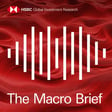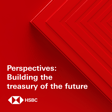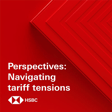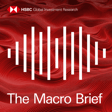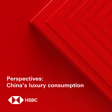Become a Creator today!Start creating today - Share your story with the world!
Start for free
00:00:00
00:00:01

US Monetary Policy and its Effect on Global Markets
In this episode of EM Spotlight, Janet Henry, Global Chief Economist at HSBC, speaks with James Bullard, President and CEO of the Federal Reserve Bank of St. Louis, on the Federal Reserve’s efforts to tame inflation and how quantitative tightening is affecting global markets. This episode was recorded from a virtual event on Sept. 29.
Emerging markets spotlight is a podcast miniseries created and hosted by HSBC that seeks to explore and understand the complex and critically important issues facing the world’s emerging markets. For further insight and information around emerging markets, visit Accessing Emerging Markets | HSBC.
Hosted on Acast. See acast.com/privacy for more information.
Transcript
Podcast Introduction
00:00:02
Speaker
Welcome to HSBC Global Viewpoint, the podcast series that brings together business leaders and industry experts to explore the latest global insights, trends, and opportunities.
00:00:13
Speaker
Make sure you're subscribed to stay up to date with new episodes.
00:00:16
Speaker
Thanks for listening.
00:00:17
Speaker
And now onto today's show.
Emerging Markets Spotlight Series
00:00:32
Speaker
Welcome to the Emerging Markets Spotlight, a podcast series from HSBC.
00:00:38
Speaker
The emerging markets landscape is more complex than ever at a time of divergent monetary policy, high commodity prices, supply chain disruptions, and geopolitical tensions.
00:00:52
Speaker
Join us as we speak with world's leading institutional investors, experts, policymakers, and thought leaders to explore the challenges and opportunities.
00:01:03
Speaker
Make sure you subscribe to HSBC Global Viewpoint and stay up to date with new episodes.
00:01:10
Speaker
Thanks for listening.
00:01:11
Speaker
And now on to today's show.
Introduction to James Boulard
00:01:18
Speaker
Hello and welcome.
00:01:20
Speaker
Thank you for joining us on the penultimate day of HSBC's Global Emerging Markets Conference for this very special session with James Boulard, President and CEO of the Federal Reserve Bank of St.
00:01:31
Speaker
Louis.
00:01:32
Speaker
My name is Janet Henry.
00:01:33
Speaker
I'm HSBC's Global Chief Economist and I'm delighted to be joined in conversation with President Boulard.
00:01:40
Speaker
Now, as you would expect in someone in his role, he's had a long and distinguished career in policymaking, in academia,
00:01:47
Speaker
And in addition to his broad ranging responsibilities at the St.
00:01:50
Speaker
Louis Fed, he has had and still has an array of other roles, only some of which include serving on the board of directors of Concordance Academy of Leadership, being a member of the editorial advisory board of the National Institute Economic Review and an honorary professor of economics at Washington University in St.
00:02:11
Speaker
Louis.
00:02:12
Speaker
And I think equally importantly, I should highlight that President Bullard has made transparency and dialogue a priority on the international and national stage as well, of course, as on Main Street.
00:02:26
Speaker
And I think that's something very clear by his willingness to engage in conversation with all of us today.
Boulard's Economic Policy Approach
00:02:32
Speaker
And despite all of his experience as an economist and a scholar, if you read anything recently on Bloomberg, on Reuters, or indeed pretty much any other financial press, Jim is typically described as known hawk for his desire to move early and swiftly on raising interest rates.
00:02:52
Speaker
But particularly for younger participants on this call, we need to remember that a decade ago, he was widely viewed as an arch-dove.
00:03:01
Speaker
He was an early advocate of QE in 2008 and then warning about the possibility of Japanese style deflation.
00:03:10
Speaker
He wrote an important paper in 2010, which helped to move the FOMC's thinking towards a second round of QE.
00:03:19
Speaker
So let's now hear from President Bullard.
00:03:21
Speaker
This will, of course, be an interactive session initially led by conversations from me.
00:03:27
Speaker
I have that privilege.
00:03:28
Speaker
But please do send in your questions on Slido and HSBC GEMS 2020 or indeed vote for others' questions.
00:03:37
Speaker
But first of all, I want to start with a fairly broad question on where the US economy and the thinking of the FOMC is right now.
FOMC Meeting Outcomes and Market Reactions
00:03:46
Speaker
So, President Bullard, thank you again for joining us.
00:03:51
Speaker
We clearly had a 75 basis point rate move in September and seemingly –
00:03:58
Speaker
A clear message from Chair Powell on near term intentions.
00:04:02
Speaker
So my question is, are you comfortable with the market's interpretation of the outcome of the meeting?
00:04:11
Speaker
Yeah, thanks very much.
00:04:12
Speaker
It's a pleasure to be here.
00:04:14
Speaker
And I'm looking forward to the questions and conversation because I always learn a lot about what's on the minds of market participants.
00:04:25
Speaker
Our recent meeting included a round of the so-called dot plot, which I've complained about at times.
00:04:33
Speaker
But here, the September meeting in particular is one where
00:04:38
Speaker
where the near time horizon shortens because you're just giving a dot for the rest of the year on the policy rate and on the other variables that are in that exercise.
00:04:51
Speaker
And if you look at the dots, it does look like
00:04:56
Speaker
The committee is expecting a fair amount of additional moves this year, at least as of the September meeting.
00:05:04
Speaker
And so I think that that was digested by markets and does seem to be the right interpretation of the
00:05:14
Speaker
For now, of course, we also have the press conference, which Jay Powell always handles very
US Inflation and Committee Measures
00:05:21
Speaker
well.
00:05:21
Speaker
And we also have the Jackson Hole speech, which Jay gave and was very forthright about what needs to be done in the U.S. because we do have a lot of inflation in the U.S. The CPI inflation rate year over year as an aid handle.
00:05:41
Speaker
That's the one that most
00:05:44
Speaker
households are seeing and that kind of inflation is very tough on low and moderate income households.
00:05:51
Speaker
If you look at other measures, the PCE measure is somewhat lower and if you want to
00:05:59
Speaker
abstract from food and energy prices or extreme movements and prices either on the high side or the low side, you might look at something like the Dallas Fed true mean inflation rate that looks at the entire distribution of price changes and throws out some
00:06:17
Speaker
on the high side and some on the low side.
00:06:19
Speaker
So there you're just looking at the center of the price change distribution.
00:06:24
Speaker
That number is 4.4% in the US, measured from one year ago.
00:06:29
Speaker
So no matter how you cut it, I'm afraid we have quite a bit of inflation in the US, way above our 2% inflation target.
00:06:38
Speaker
And that's why the committee has moved aggressively this year starting in the second quarter
00:06:45
Speaker
really the end of the first quarter, I guess, to try to get policy positioned to bring inflation down in as expedient a way as we can,
00:07:02
Speaker
And we're hopeful that by acting sooner and with transparency and with clear communication that we'll be able to get inflation down now, as opposed to the 1970s where inflation at these levels lingered for 15 years
US Labor Market Strength
00:07:25
Speaker
or so.
00:07:25
Speaker
And the problem with the 1970s was that we had
00:07:31
Speaker
not just high inflation, it wasn't just that you were putting up with the price increases, it's that the real economy was also volatile during that period.
00:07:40
Speaker
You had four recessions in 13 years, culminating in the
00:07:45
Speaker
1981-82 recession where the unemployment rate in the US went to double digits.
00:07:52
Speaker
So it's imperative, I think, that we avoid that kind of scenario, that we remain credible and consistent about our 2% inflation target, that we take action to move inflation back to 2%.
00:08:08
Speaker
And so that's been a theme, I would say, during this part of the cycle.
00:08:15
Speaker
Now, I can talk about other parts of the outlook, labor market, but maybe I'll just briefly say a few things and then we can elaborate as we go forward here.
00:08:33
Speaker
But the labor markets in the US are extremely strong.
00:08:36
Speaker
And if you want to ask about that, I'll go into more detail, but I think
00:08:43
Speaker
You know, claims this morning came in at under 200,000.
00:08:46
Speaker
It's a super low number for the US.
00:08:49
Speaker
And that was something that during the summer people were saying was rising, but it's not.
00:08:56
Speaker
But many other measures of labor markets continue to indicate a lot of strength there.
00:09:03
Speaker
GDP, we can talk about that.
00:09:05
Speaker
We actually had negative GDP growth in the first quarter and second quarter, but I'm looking for... That's a bit inconsistent with the strong labor market, so we can talk about that issue as well.
00:09:18
Speaker
So most people's assessment is that that doesn't seem to be the right metric right now to think about the US economy.
00:09:29
Speaker
And of course, we also have international considerations, which I think will be front and center here, probably.
00:09:36
Speaker
Right.
00:09:37
Speaker
Thank you for that.
00:09:38
Speaker
And you touched on a lot of points.
00:09:40
Speaker
And I can see looking at SIDO that the questions are already piling in.
00:09:44
Speaker
But first of all, I wanted to pick up on a few of the things that you already said.
00:09:48
Speaker
And you did mention the labor market in particular.
00:09:51
Speaker
As you said, looking at the initial jobless claims of under 200,000, by that report, it does still seem to be a labor market that's still very hot.
Labor Market and Inflation Control
00:10:01
Speaker
I know you've mentioned that the Kansas City's Fed Labor Market Index and vacancies to unemployment ratio is still very high.
00:10:08
Speaker
That seems to be happening at the national level.
00:10:11
Speaker
So I suppose one of the questions is, especially when we're thinking about inflation going forward,
00:10:17
Speaker
how much softening would you be looking to see from indicators such as job openings and unemployment and wage growth before you would be comfortable with the idea of pausing on rate hikes?
00:10:29
Speaker
And perhaps as part of that, you might pick up on the whole beverage debate.
00:10:34
Speaker
It's a strange world when even non-economists are talking about beverage terms, but suddenly everyone seems to be aware of the Feds Waller and Figueroa paper that
00:10:45
Speaker
We really don't need to see unemployment rise because vacancies are just going to fall back in line.
00:10:50
Speaker
But clearly, you've got Summers and Blanchard on the other side of the debate that we would need to see 6% unemployment or so.
00:10:58
Speaker
So, yeah, what would you look at?
00:11:00
Speaker
And do you have a view on what the new narrow is?
00:11:02
Speaker
Or do you just wait to see what it takes for wage growth to come down?
00:11:08
Speaker
Yeah, I think it's just a very tight labor market, no matter how you cut it.
00:11:15
Speaker
I do like to look at the Kansas City Fed's Labor Market Conditions Index because that aggregates many different measures of labor market performance.
00:11:25
Speaker
into one single metric and it is at a high that is similar to the late 1990s and the late 1990s in the US was considered the best labor market of the entire post-war era so we're really at that kind of level as far as labor market performance in the US.
00:11:47
Speaker
You've got this
00:11:49
Speaker
vacancies, two vacancies for every unemployed worker.
00:11:52
Speaker
So it does seem like even a worker that became unemployed today, the firm had trouble and got rid of some workers, then that person would still have quite a few choices to get back into the labor market and get back into a good job.
00:12:11
Speaker
So I think
00:12:15
Speaker
It's very encouraging to have that kind of labor market, but it also means that this is probably a good time to try to get the inflation under control while the labor market's performing so well.
00:12:28
Speaker
Now, on that beverage curve, I think the Figueroa-Waller argument is carrying the day.
00:12:35
Speaker
So far, the job openings, I guess they've fluctuated some, but they've come down since earlier this year, and the unemployment rate really hasn't moved.
00:12:48
Speaker
So that would be consistent.
00:12:52
Speaker
with their argument, which I think is more of a short-term argument.
00:12:55
Speaker
I would see Blanchard Summers thinking more like two years out into the future.
00:13:01
Speaker
If you think that far into the future, then probably unemployment will return to mean and job openings will return to mean over a two or three year period.
00:13:13
Speaker
I think that's probably a simple sort of forecast that everybody would make.
00:13:18
Speaker
3.7% unemployment in the US is not the most common thing if you look at the post-war data.
00:13:26
Speaker
So if it goes up as the summary of economic projections indicated to something like 4.4%,
00:13:34
Speaker
I would interpret that as just a return to mean of the unemployment rate to something closer to the natural rate of unemployment for the US economy, which is often estimated to be four and a quarter to four and a half percent.
00:13:48
Speaker
And of course, has wide confidence bounds around those estimates.
00:13:51
Speaker
So, you know, I don't think it's reasonable to expect that you'd stay at 3.7 percent for a long time into the future.
00:14:02
Speaker
But with all these job openings, maybe that's what will happen.
00:14:06
Speaker
I have a hard time seeing the unemployment rate go up very much with all these job openings because it would be so easy right now anyway for a worker that got displaced to find a new job.
00:14:18
Speaker
We've also got quits at high levels, which is indicating that people are confident that they can quit their job and take a new job.
00:14:27
Speaker
So that's happening as well.
00:14:29
Speaker
So a lot to like about the labor market and it suggests that the Fed can concentrate on the inflation part of its mandate.
00:14:40
Speaker
Thank you.
00:14:41
Speaker
And I want to turn to global developments, but at the moment I want to stay on the subject of further tightening of policy because I'm getting some questions on the housing market.
Monetary Policy: Balance Sheet Runoff
00:14:55
Speaker
You might want to touch on that.
00:14:56
Speaker
But the other one that I wanted to ask you about
00:14:58
Speaker
is really the role of the balance sheet in policy as opposed to just interest rates.
00:15:03
Speaker
And that's really one of the factors that are most important to keep in mind when considering the longer term size and composition of the balance sheet.
00:15:12
Speaker
But also just the question of to what extent does quantitative tightening actually tighten financial conditions?
00:15:19
Speaker
Is it just a signaling of policy or do you think it is something that is tightening US financial conditions or indeed global financial conditions?
00:15:30
Speaker
Well, I was pleased that we got the balance sheet runoff started in the second quarter of this year.
00:15:38
Speaker
We phased that in, so it's really just hitting full stride, I believe, here in September.
00:15:47
Speaker
And my preference is to kind of wait and see on that part of the policy how things are developing at least six months or even longer to make sure that
00:16:01
Speaker
It's doing what we think it's doing, which should be to help put upward pressure on the longer end of the yield curve.
00:16:09
Speaker
compared to what it would otherwise be.
00:16:11
Speaker
I think we were a little late in getting started on the balance sheet runoff.
00:16:19
Speaker
Financial conditions actually stabilized a lot, even in the fall of 2020.
00:16:28
Speaker
It's true that in March and April of 2020, financial stress measures, such as the St.
00:16:33
Speaker
Louis Fed's financial stress measure, were at 2008 level.
00:16:37
Speaker
So at that point, it looked like
00:16:39
Speaker
you could have a financial crisis on top of the pandemic, and that would have been a clear disaster, I think.
00:16:48
Speaker
But we avoided that, and financial conditions eased considerably by the time we got to the fall of 2020, and we could have contemplated somehow thinking about, okay, well, maybe we don't need all these purchases as we go through.
00:17:03
Speaker
Also, I think the initial...
00:17:07
Speaker
of asset purchases was to include the mortgage-backed securities in that calculation because I thought, and I think probably everyone thought, well, that the housing market would have trouble as we tried to make our way through the pandemic.
00:17:24
Speaker
But it turned out to be the opposite case where the housing market actually boomed in the US and prices were up
00:17:32
Speaker
dramatically until just now with finally turning down a little bit, but they've been up dramatically in the US.
00:17:41
Speaker
And I argued that in 2021, that maybe we shouldn't be feeding into that process.
00:17:47
Speaker
But we had to look for the right moment to pull back our asset purchases.
00:17:52
Speaker
We got that going in the spring of this year.
00:17:55
Speaker
And now I want to see how that affects the economy.
00:17:59
Speaker
As you know, the academic
00:18:01
Speaker
estimates on this are all over the map and even the market commentary is is widespread so it's kind of a part of the policy it's hard to assess and we're obviously focused on the interest rate uh part of our uh the interest rate part of our toolkit right now so uh i like having the qt going on because i think that's helping us but to what degree it's helping us i think is a good question and
00:18:28
Speaker
something I want to get feedback on from financial markets and elsewhere as we go forward.
00:18:34
Speaker
Yeah, absolutely.
00:18:35
Speaker
As you say, it's trying to forecast something we have little or no experience of historically, but there are no shortage of estimates out there from... I do want to say one other thing about this that I like to emphasize, which is that in other parts of the last 15 years, you might have one central bank with a quantitative easing program and not the other major central banks.
Global Central Bank Coordination
00:19:03
Speaker
But here you've got central banks moving in the same direction on this dimension.
00:19:09
Speaker
And so it's a global QT and I'm anxious to see to what extent that affects global financial conditions.
00:19:18
Speaker
So we'll see as we go forward, but we'll keep an eye on this.
00:19:22
Speaker
But the balance sheet expanded a lot in the US and I think we can pull back and get some help on our inflation objective through this channel.
00:19:33
Speaker
And related to that, as you say, even though there is a global monetary tightening underway, in many ways it is being led by the world's most important central bank, which is, of course, the Federal Reserve.
00:19:46
Speaker
And I suppose in the course of the last week, particularly sitting here in London,
00:19:53
Speaker
It's clear that what's happening, the global tightening, like it or not, is coming through thick and fast.
00:19:59
Speaker
You've seen some central banks globally being reluctant to raise rates for one reason or another.
00:20:06
Speaker
They've been intervening on their currency.
00:20:08
Speaker
But I suppose the setting policy primarily, well, entirely for the US economy,
00:20:15
Speaker
and US inflation.
00:20:18
Speaker
How are you thinking about some of these global influences?
00:20:21
Speaker
I know that the US dollar policy sits with Treasury, but a strong dollar and the impact of a strong dollar on the rest of the world.
00:20:29
Speaker
How does that impact on the FOMC's discussion on inflation?
00:20:32
Speaker
Because I suppose it's quite helpful in the fight against inflation.
00:20:38
Speaker
And related to that, I suppose partly to do with the strength of the dollar, the volatility that we are seeing in global markets.
00:20:44
Speaker
How does that feed into the discussions and the way that you think about the outlook for what is appropriate policy for the US economy?
00:20:54
Speaker
Well, we certainly do look at international developments carefully and try to calibrate what the impact will be back to the U.S. I have been pleased as we got going here in 2022 that many central banks around the world anticipated
00:21:13
Speaker
Fed action and moved ahead of the Fed as part of their policy, understanding where the Federal Reserve was likely to go going forward, understanding the inflation situation in the US and that we were going to have to act aggressively to bring inflation under control.
00:21:32
Speaker
And so I think that has helped.
00:21:37
Speaker
limit the damage that might have otherwise occurred from, let's say, a surprise move in the US that other central banks didn't have time to react to.
00:21:49
Speaker
We certainly heard a lot about this.
00:21:52
Speaker
in the earlier era, the quantitative easing era, where foreign central banks said that they were surprised by Fed action and they weren't sure what our policy was, and then this was feeding back to them.
00:22:05
Speaker
But here, I think we've made it clear and we've been forthright.
00:22:09
Speaker
We've got a lot more transparency about what we're trying to do.
00:22:14
Speaker
And that has allowed many central banks around the world to act in tandem and calibrate their policies appropriately for their jurisdictions as the Fed was moving.
00:22:27
Speaker
So that part, I think, has helped us a lot this year to limit the sorts of disorderly adjustment that might otherwise occur.
00:22:41
Speaker
And, you know, obviously, we've got a, you know, the UK has been the focal point just here in recent days.
00:22:48
Speaker
But I would just step back from that a little bit and say that the broader picture, considering how much we've moved and how fast we've moved, I think the transparency and forthrightness in the communication around this has worked to our advantage globally.
00:23:05
Speaker
And and, you know, overall, I think we've had a pretty good response.
00:23:12
Speaker
So the strength of the dollar at the moment, as you say, you watch it as it goes along.
00:23:15
Speaker
But I don't want to dwell on the dollar too long, but there are a lot of questions related to it.
00:23:20
Speaker
So I just want to draw on a couple of these.
00:23:23
Speaker
I think you kind of addressed it.
00:23:25
Speaker
Has the dollar strengthened enough yet to be a factor in policymaking for the US?
00:23:31
Speaker
But also a couple of questions relating to the financial stability angle.
00:23:36
Speaker
Given the ascent of the dollar and so many currencies, is there a risk
00:23:41
Speaker
But I suppose there always has to be a risk, doesn't there?
00:23:43
Speaker
That somewhere in the world you could have a financial event that could have a feedback effect into the U.S. economy.
00:23:49
Speaker
Someone's likened it to an LTCM type of risk.
00:23:56
Speaker
Yeah, I think this is something we're always watching and always monitoring.
00:24:03
Speaker
If you look at the 94 tightening cycle, which was also 300 basis points at that time, you one day woke up and you got Orange County, California, California.
00:24:19
Speaker
declaring bankruptcy.
00:24:20
Speaker
So I think that's the sort of thing that can happen.
00:24:23
Speaker
LTCM was another episode in the annals of
00:24:31
Speaker
financial instability.
00:24:32
Speaker
So we do watch this very carefully.
00:24:37
Speaker
I think, but I also think that by being clear and having forward guidance on likely moves going forward, that you can mitigate some of that risk because people aren't taken by surprise as much as they otherwise would have been by the, you know, by the
00:24:59
Speaker
upward movement at the short end of the yield curve.
Market-Based Inflation Expectations
00:25:03
Speaker
I think, you know, so far so good, but I would continue to watch this carefully.
00:25:11
Speaker
Yes, yes, of course.
00:25:14
Speaker
And on the, going back to inflation, because the top question on Slido by far is about CPI, the reported CPI.
00:25:27
Speaker
So the question is, is the Fed two-focused brackets backward-looking on year-on-year CPI?
00:25:34
Speaker
I mean, I would disappoint you that.
00:25:36
Speaker
I think it's very clear that the U.S. does look
00:25:39
Speaker
at monthly inflation rates, and thus given long lag times for policy efficacy.
00:25:44
Speaker
I think the basic question is, and we're getting a few of them, is are the risks increasingly skewed towards over-tightening rather than under-tightening by looking at these reported inflation figures?
00:26:01
Speaker
I don't really think so.
00:26:02
Speaker
I think, at least speaking for myself, my goal has been to get the policy rate to a level that I think is reasonable for this environment.
00:26:14
Speaker
And just to remind everybody, we started at near zero, which I think was not reasonable.
00:26:20
Speaker
And so we've had to move a lot in a short period of time.
00:26:25
Speaker
However, I think we can get to a level that makes sense.
00:26:29
Speaker
And then at that point, I think you could argue that we'd be back to more ordinary sort of monetary policy where you'd be taking account of the recent data and you'd be
Transition from Pandemic Policies
00:26:42
Speaker
making adjustments or standing pat depending on how the data has come in.
00:26:50
Speaker
But starting out at the beginning of 2022 here, we were still in...
00:26:57
Speaker
pandemic mode, which maybe was appropriate still, but as we've moved to the endemic phase of the pandemic and we've had much higher inflation than anticipated, it's been imperative that we move the policy rate off the near zero level and get up to some level that would be appropriate for the amount of inflation that we have, and we have quite a bit.
00:27:22
Speaker
If you do some kind of Taylor rule calculation,
00:27:27
Speaker
The Taylor Rule calculation that you do will be dominated by the amount of inflation that you put in the inflation gap part of the Taylor Rule.
00:27:36
Speaker
So it's almost all being driven by inflation.
00:27:40
Speaker
You have to make other assumptions there about the real short-term interest rate and output gaps and things like that, coefficients that you want to use.
00:27:48
Speaker
But no matter how you cut it, that inflation gap term is going to be the dominant.
00:27:56
Speaker
term.
00:27:57
Speaker
So those that are listening here and want to see what I've been thinking about that, I did give a talk at Stanford in May that addressed that issue.
00:28:09
Speaker
And that calculation at that time said, well, the minimal level that we have to get up to is probably three and a half percent.
00:28:16
Speaker
But
00:28:17
Speaker
Unfortunately, since that time, that was only May, that's only four months ago.
00:28:22
Speaker
But since that time, the data has come in even worse than we were anticipating.
00:28:28
Speaker
And if you do that over again, you get more like four and a half percent on that kind of calculation.
00:28:34
Speaker
You saw that in the dot plot.
00:28:37
Speaker
that came out in September where the dots on policy had moved up quite a bit for 2022.
00:28:44
Speaker
But I think appropriately, given that markets and us were expecting inflation to moderate, it didn't really, it didn't moderate, went in the other direction.
00:28:55
Speaker
So on this issue about, you're looking at this lagging indicator of inflation and is that really the right thing to do?
00:29:03
Speaker
I think,
00:29:05
Speaker
We do pay a lot of attention to inflation expectations, and I, in particular, like the market-based measures of inflation expectations that are derived from the TIPS market, also inflation swaps and other methods.
00:29:20
Speaker
And I'm pleased that those have come back down under 3%, even under 2.5% five-year and five-year forward.
00:29:33
Speaker
So that's very encouraging from my point of view.
00:29:36
Speaker
Markets are expecting inflation to come back under control at those kinds of horizons.
00:29:41
Speaker
And I think that's exactly what we need here.
00:29:43
Speaker
Plenty of credibility on that.
00:29:45
Speaker
However, markets are also wrong sometimes about what's actually going to happen.
00:29:50
Speaker
And we're also wrong sometimes.
00:29:51
Speaker
So I think there's a risk management element to this where we stay higher for longer to make sure that we're actually seeing the disinflation that we're going to need to send inflation back to 2%.
00:30:03
Speaker
Yes, as you say, markets are sometimes wrong.
00:30:06
Speaker
And I suppose financial markets still are based on what central banks are telling them.
00:30:12
Speaker
And most central banks in the world, if they have a broadly speaking, a 2% inflation target in two years time, they're pretty much always forecasting that it's going to get back to 2% kind of levels.
00:30:25
Speaker
And actually, I think that feeds into the whole framework at the moment.
00:30:30
Speaker
It's very clear that the intent is to raise rates swiftly, to get them back to an appropriate level, and at least get them a bit more restrictive as soon as possible.
00:30:41
Speaker
So I don't think anyone doubts the intention that the Fed and others want to prevent a wage price spiral and get inflation on a downward track.
00:30:50
Speaker
But it's interesting, when I talk to clients, and I've been in Singapore earlier this week,
00:30:54
Speaker
It was remarkable how many people asked the question, are we ever going to get back to 2%?
00:30:59
Speaker
Even though a central banker isn't going to say it, once we get back to maybe 3%, isn't that enough?
00:31:07
Speaker
We're not going to continue to squeeze the economy to the intent on getting to the 2% level.
00:31:14
Speaker
So maybe you could talk a little bit about that as much as, you know, one, I suppose, is there any possibility that an inflation target is moved or would that be dangerous in itself?
00:31:25
Speaker
Are you worried that people are asking that question, that central banks are just not going to stick to their policy until they get back to that 2% level?
00:31:35
Speaker
How do you think about not just financial market measures of inflation expectations, but the fact that these conversations are now being had?
Inflation Target Debate
00:31:45
Speaker
Yeah, I think, you know, the notion that you would start to mess around with the inflation target right when you get challenged with high inflation, that sounds like a replay of the 1970s to me.
00:31:57
Speaker
And so I think this is just a totally bad idea.
00:32:01
Speaker
And, you know, I know people are...
00:32:03
Speaker
are talking about that, but we'll maintain credibility inflation target.
00:32:07
Speaker
We will push inflation to 2% and we'll do it in a reasonably compact timeframe.
00:32:16
Speaker
So I think the thing about the 2% target is that it was enormously successful since the 1990s when it was first introduced.
00:32:28
Speaker
and has been adopted around the world as a global standard.
00:32:31
Speaker
So I think if you had a major central bank like the Fed deviating from that, that you'd have other central banks then also deviating and you'd get a chaotic situation around the world where you're back in the 1970s soup where economies are volatile, recessions are common.
00:32:53
Speaker
and inflation is high and variable.
00:32:55
Speaker
So I don't think we want to go in this direction.
00:32:59
Speaker
What you want to do is press on to get inflation back to 2% as soon as it's reasonably possible.
00:33:09
Speaker
And I think it is possible because I think what's really going on here, a better way to think about it is that we've been through a war.
00:33:20
Speaker
George Hall of Yale University and Tom Sarge of NYU have a paper called Financing Three World Wars.
00:33:27
Speaker
And what they meant was World War I.
00:33:29
Speaker
World War II and the pandemic.
00:33:31
Speaker
And I think it is like a war in the sense that the national crisis occurs.
00:33:40
Speaker
The government borrows a lot of money to pay for mitigating the crisis.
00:33:47
Speaker
and the central bank accommodates that borrowing.
00:33:52
Speaker
But this all makes sense because you're in a national crisis as we were in, especially in March and April of 2020.
00:34:01
Speaker
And then, but then the war is over and we know wars around the world, both for the winners and losers tends to create inflation.
00:34:09
Speaker
But when the war is over, you switch back to the pre-war policy of less deficit spending and
00:34:16
Speaker
and a monetary authority that concentrates on its inflation target.
00:34:21
Speaker
And that to me is exactly what's happening in both on the fiscal side in US politics and also on the monetary side with the FOMC that you're switching back to the pre-pandemic policy.
00:34:35
Speaker
And what this does is drive inflation expectations right back to the target and actual inflation follows behind and comes right back to target.
00:34:44
Speaker
So
00:34:45
Speaker
I'm hopeful that we can get that kind of dynamic going.
00:34:48
Speaker
And I think we're in process here of having exactly the right kind of policy to get that to happen.
00:34:54
Speaker
So it's not coming through Phillips curve, according to my assessment here.
00:35:00
Speaker
And that's why I de-emphasize labor markets.
00:35:02
Speaker
The Phillips curve is very flat in the US.
00:35:06
Speaker
And if you tried to use that channel to get inflation down, unemployment would really have to go to very high levels.
00:35:14
Speaker
I'm not quite sure what people have in mind that are talking through that kind of language about how we're going to get inflation down.
00:35:23
Speaker
I don't think that's how this works.
00:35:24
Speaker
What you do is you get inflation expectations back to the 2% target.
00:35:30
Speaker
And you get a disinflationary process going in the US that doesn't have that much to do with labor markets themselves and has more to do with the pricing power of firms and the fear of firms that they might lose market share if they
00:35:46
Speaker
continue to be cavalier about their price increases.
00:35:48
Speaker
That's my interpretation of the 1980s as to what happened.
00:35:53
Speaker
Those firms that were lazy and thought they would just increase prices whenever they wanted got put out of business by other firms that were productivity oriented and low cost oriented.
00:36:06
Speaker
And those latter firms carried the day that drove a fierce disinflationary process that pushed inflation down dramatically in the U.S. So I think we can get that kind of process going.
00:36:19
Speaker
We'll see disinflation in the U.S. and we'll get back to the target in a relatively short time frame.
00:36:25
Speaker
Thank you for that, because actually the top question here, but I think you've answered it already, is how much of inflation is related to supply issues?
Impact of Global Supply Issues on Inflation
00:36:33
Speaker
Is there a risk that higher rates bring demand down, but inflation remains high due to supply constraints?
00:36:39
Speaker
But I'd be happy to add anything if you want to on that, but it's still in terms of the policy setting.
00:36:46
Speaker
Yeah, I mean, yeah, we do.
00:36:48
Speaker
Of course, we look at global commodity prices.
00:36:51
Speaker
They have come off their highs.
00:36:52
Speaker
And you've got other, obviously, factors driving that with the war in Ukraine and to some extent Chinese policy as well.
00:37:02
Speaker
So, yeah.
00:37:04
Speaker
But the numbers I cited at the beginning for the Dow Sped trim mean inflation rate, you're already throwing out the most extreme increases and decreases in the price change distribution.
00:37:16
Speaker
You're just looking at the center of the price change distribution, and that is still 4.4% in the US.
00:37:22
Speaker
So you might interpret that as the
00:37:25
Speaker
the inflation that the Fed has to take care of as opposed to the inflation that might be due to global factors that are bouncing up and down because of the war or because of Chinese policy.
00:37:44
Speaker
So I think this notion of throwing out food and energy or using some other method to look at the center of the price change distribution gets at the question of commodity price movements.
00:37:59
Speaker
And I think it's clear that we have to act even more.
00:38:05
Speaker
knowing what's happening with commodity prices, but we have to act because the center of the price change distribution is also moving pretty aggressively and we have to get that part under control.
00:38:17
Speaker
And in terms of getting back to the whole policy framework regarding inflation, flexible average inflation targeting, is it over?
00:38:29
Speaker
Is it just back to 2% core PCE now and always?
00:38:34
Speaker
Or is there, and you've mentioned Taylor rules a couple of times in this discussion already, that at least gives you an assessment of where the current appropriate policy setting might be.
Role of Taylor Rules in Policy Setting
00:38:45
Speaker
But are there advocates on the FOMC, do you think, for a more systematic rates policy like a Taylor rule?
00:38:51
Speaker
Or do you see, you know, flexible average inflation targeting being talked about again a lot more?
00:38:57
Speaker
Or is it just we're getting back to 2% for PCE?
00:38:59
Speaker
Yeah.
00:39:04
Speaker
I think Taylor rules were developed in an era of trying to explain the 80s and the 90s, which is pretty successful policy in the US and which did bring inflation by about 1995 to 2%.
00:39:19
Speaker
And over the 95 to 2005 period, inflation was averaged almost exactly 2%.
00:39:27
Speaker
So pretty successful.
00:39:31
Speaker
I think that those rules were...
00:39:35
Speaker
not designed to talk about the effective lower bound and so that you had a lot of trouble once we hit the zero lower bound after the global financial crisis.
00:39:45
Speaker
You had a lot of trouble talking about policy in tailored rule terms.
00:39:50
Speaker
But now that we're back
00:39:53
Speaker
Sorry, back in the higher inflation environment, it makes complete sense, I think, again, to think in terms of Taylor rules as far as where the level of the policy rate should be.
00:40:04
Speaker
So I'd certainly be an advocate of looking at that and considering that as giving us a recipe for the right types of
00:40:14
Speaker
of policy moves to make in this environment now.
00:40:19
Speaker
A lot would depend on exactly what inflation gap are you going to put into that Taylor rule.
00:40:25
Speaker
Because if you just take CPI inflation and take the inflation target off and multiply it by something, you're going to get a very, very high
00:40:33
Speaker
policy rate.
00:40:36
Speaker
Maybe that's not the way to think about it, but I think to look at other measures of inflation that throw out the most extreme movements.
00:40:49
Speaker
on the high and the low side would give you a better, a more realistic idea of where you should be on the policy rate.
00:40:58
Speaker
As far as the flexible average inflation targeting framework, I guess what I'd like to say about that is that you should draw a little picture in your mind.
00:41:08
Speaker
And there are two branches in this picture.
00:41:11
Speaker
One is the low inflation branch.
00:41:15
Speaker
and the effective lower bound branch.
00:41:17
Speaker
And the other is the high inflation branch.
00:41:20
Speaker
And on the low inflation branch, monetary policy should be looking at flexible average inflation targeting framework because that was designed to talk about the effects of the zero lower bound on monetary policy.
00:41:37
Speaker
What do you do in a world where inflation is very low and nominal interest rates are very low?
00:41:43
Speaker
How do you conduct stabilization policy in that environment?
00:41:46
Speaker
That's what the flexible average inflation targeting framework was for.
00:41:52
Speaker
If it's a high inflation environment, it's just C Volcker.
00:41:58
Speaker
So we know, as it was often said as we were developing the flexible average inflation target framework, well, if inflation is high, we know what we have to do.
00:42:08
Speaker
And so we're not trying to design something for that.
00:42:12
Speaker
We know that we will have to conduct policy in a way to return inflation to target from the high side.
00:42:19
Speaker
The question is, when inflation is very low, it's below your target and nominal interest rates are very low, how should you conduct monetary policy then?
00:42:27
Speaker
So there are kind of two branches to this.
00:42:30
Speaker
If inflation is low, then inflation.
00:42:32
Speaker
I think fate might still be very relevant, but if inflation is high, we got the recipe from the Volcker era.
00:42:42
Speaker
Absolutely.
00:42:43
Speaker
You mentioned Taylor rules being devised during the 80s and the 90s and used then, but for the last couple of decades, perhaps less so, which is
00:42:54
Speaker
It leads me to a question regarding globalization effects.
00:42:57
Speaker
We think about the last few decades in particular when we had persistent globalization until a couple of years before the pandemic and a lot of automation in the goods sector.
00:43:09
Speaker
How much of the last 20 years would you say the low stable inflation was a function of central bank credibility?
00:43:17
Speaker
But to what extent did central banks also get lucky by global developments?
00:43:22
Speaker
And that actually now maybe we are in a more volatile world.
00:43:28
Speaker
Maybe it is just going to be more like the 70s or the 80s where we get external factors, whether it's a war, a pandemic or deglobalization forces are just persistently going to mean an era of more volatility in activity and in inflation and potentially interest rates.
00:43:47
Speaker
Yeah, I mean, inflation targeting is inflation targeting.
00:43:50
Speaker
And it doesn't say, oh, you could miss your inflation target if there's globalization going on or there's de-globalization going on.
00:43:59
Speaker
I think the whole key to this is to take those factors into account appropriately and then to put it in Milton Friedman kind of terms, print the right amount of money for the situation that you're in.
00:44:13
Speaker
so that you hit the inflation target.
00:44:15
Speaker
So that's the art of central banking.
00:44:17
Speaker
But just because there are factors, winds are blowing in one direction or another, doesn't mean that you can't hit your inflation target.
00:44:26
Speaker
I think you still can, but it's sort of the amount of money that you have to print is somewhat different in one situation versus another.
00:44:37
Speaker
So I push back a little bit against these kinds of arguments to say, well, we're going to miss on the high side for a long time because of some kind of factors.
00:44:47
Speaker
We should be taking those into account and then conducting the right monetary policy in that environment so that we hit the inflation target.
00:44:55
Speaker
If you continually miss your inflation target, then you just lose credibility on the entire policy and markets start the doubt that you're trying to do anything at all.
00:45:07
Speaker
That's the recipe for the earlier era in the 70s where inflation drifted around in all different countries and you had high variable inflation and a volatile real economy, lots of recessions.
Adapting Monetary Policy to Global Changes
00:45:21
Speaker
So I appreciate that the fundamentals of the global economy may be changing and probably are changing, but our job is to take those into account and get the right monetary policy given those changes.
00:45:37
Speaker
So I suppose if it is going to be a world where we are subject to perhaps less favorable influences on inflation, it sounds like you are talking about a world of a deterioration in the growth inflation tradeoff.
00:45:52
Speaker
And I wanted to link that into the idea of the dots.
00:45:55
Speaker
You started off with the dots, what they were pointing to for the end of the year, which is that in September doesn't leave too much scope for a big divergence so late in the year.
00:46:05
Speaker
But a few years ago, you said you wouldn't submit a long term dot such that that dot wasn't particularly useful.
00:46:13
Speaker
So what is that still your view that, you know, in this particularly uncertain world that a long term dot is not useful?
00:46:22
Speaker
But also, could you just talk, even if there isn't a number on it, do you have any thoughts about even the direction of the long-term equilibrium rate or natural rate?
00:46:32
Speaker
A few years ago, you'd suggested that some demographic factors, productivity factors and demand for safe assets might mean a persistently low natural interest rate.
00:46:43
Speaker
Or do you think that there are factors that may have forced it a little bit higher in terms of the long-term natural rate?
00:46:53
Speaker
Yeah, this is a great thing to talk about further.
00:46:58
Speaker
I think when we do this dot plot, the place where there's the most uncertainty is actually the long run column there where people are saying where we're going to be 10 or 20 years from now or something like that.
00:47:15
Speaker
And there's actually tremendous amounts of uncertainty about that.
00:47:18
Speaker
And I would say if you look at economic history, there are long eras of, let's say, high productivity growth or low productivity growth.
00:47:29
Speaker
There are changes in demographics over very long time periods.
00:47:33
Speaker
And so I think that
00:47:37
Speaker
You're better off thinking about, well, if we could be in, say, a low productivity era in the future, and that would dictate one type of monetary policy, but you could be in a high productivity era in the future, and that would dictate different levels of the policy rate and so on.
00:48:00
Speaker
Because of that, I did quit submitting longer run dots, except on the inflation target, because I think given those fundamentals, you should be able to conduct a policy that hits your inflation target if you understand what the fundamentals are for the economy.
00:48:20
Speaker
But I still like the regime switching idea.
00:48:24
Speaker
If you look back historically, and there are clearly periods
00:48:28
Speaker
that are dominated by certain types of fundamental developments.
00:48:32
Speaker
And then there are other long periods that are developed by, that are characterized by other types of developments and monetary policy would have to be different in those two worlds.
00:48:42
Speaker
So averaging across those and saying, well, that's your long run,
00:48:47
Speaker
that's your long run outcome is not really giving you the right picture of how the world works.
00:48:54
Speaker
I think it's you take that average, that average is something that never occurs.
00:49:00
Speaker
You're either in the high regime or the low regime.
00:49:03
Speaker
So you're kind of getting the wrong idea if you look at that.
00:49:08
Speaker
Also, the long run part of the dot plot or any forecast, because there's a lot of mean reversion, that gives you this path for the policy rate and for other variables.
00:49:22
Speaker
Because what happens is you just take from wherever you are today and then you draw a line back to whatever you think the mean is in the long run.
00:49:30
Speaker
uh and that's that path is what's critical for the uh implementation of monetary policy but but the path could be far away from uh what is realistic because you don't know what the long run outcome is and so you're drawing paths into uh to a dot that has a lot of uncertainty around it so this is kind of
00:49:54
Speaker
but I think this is an important consideration for how we communicate policy.
00:50:04
Speaker
Yeah, no, I would agree with that.
00:50:05
Speaker
And in fact, there's a question here that a lot of people like the sound on, actually.
Positive U.S. Real Yields and Policy Goals
00:50:11
Speaker
How do you interpret U.S. real yields now all comfortably over one and a half percent?
00:50:23
Speaker
I've been pleased that we've been able to get real yields higher.
00:50:28
Speaker
And I think that that is consistent with our policy goals and consistent with the idea that we want to get inflation back down to 2%.
00:50:38
Speaker
I would say overall, it's still a low real interest rate world, but to have real interest rates above that low level now and into positive territory is an encouraging sign.
00:50:53
Speaker
OK, so we're still there because that was another question.
00:50:55
Speaker
I'm going to spend the last eight minutes on questions all on Slido.
00:50:59
Speaker
The next question was, has higher for longer now officially replaced lower for longer?
00:51:04
Speaker
It sounds like you're saying we're still there, just not at the lower leg.
00:51:08
Speaker
I would say on the higher for longer question.
00:51:14
Speaker
I do think that markets and maybe policymakers too are coming around to the view that, okay, well, we have quite a bit of inflation.
00:51:23
Speaker
It will take a while for it to go back to 2% and it probably won't go back in a straight line.
00:51:30
Speaker
You wouldn't ever expect that.
00:51:31
Speaker
And the Fed is going to have to be careful about not over-interpreting a decline in inflation as it goes back to 2%.
00:51:42
Speaker
So all those things seem to indicate that you have
00:51:45
Speaker
a higher policy rate for longer than markets might have thought even one year ago.
00:51:55
Speaker
This isn't the kind of thing where you can just move the policy rate up and everything corrects itself immediately.
00:52:01
Speaker
That's not how macroeconomics work.
00:52:03
Speaker
So even though I gave a story about why I think this will be successful and happen in a relatively short timeframe, that still probably means higher for longer than what markets would have anticipated previously.
00:52:18
Speaker
Right.
00:52:18
Speaker
Okay.
00:52:19
Speaker
Thank you for...
00:52:21
Speaker
But on your point that when you set policy, it doesn't always work in a straight line against everything you're trying to influence.
00:52:28
Speaker
There are a few questions here related to what you're looking for on the inflation side and on the labor market side.
00:52:33
Speaker
I mean, obviously, the Fed does have a dual mandate at the moment.
00:52:38
Speaker
Unemployment is arguably too low.
00:52:39
Speaker
The labour market's too tight.
00:52:41
Speaker
Inflation's definitely too high.
00:52:43
Speaker
You know, both goals are quite consistent.
00:52:46
Speaker
Presumably, as tightening continues, you will see that the prospect, especially if inflation is lagging, any rise in unemployment, that the goals may no longer be consistent.
00:52:59
Speaker
Or do you not think that's possible?
00:53:00
Speaker
Do you think for now,
00:53:02
Speaker
It will be the inflation concerns that will dominate what the Fed does regarding decisions as to when to take a pause on the tightening side.
00:53:14
Speaker
Yeah, I would just point to the 1990s, which was a very good decade for the U.S. on the whole.
00:53:22
Speaker
We did have this tightening cycle in the middle of the 90s.
00:53:26
Speaker
And then by the late 90s, the policy rate was actually quite a high level, unimaginably high compared to what we got used to after that.
00:53:35
Speaker
And the unemployment rate went all the way down to...
00:53:40
Speaker
David Steinemann, MD, You know, below 4%.
00:53:43
Speaker
So by 2000, we did have a recession, kind of a mild recession at that point.
00:53:47
Speaker
But I don't think it's quite as mechanical as what people make it out to be.
00:53:53
Speaker
The dot plot did suggest that unemployment would tick up here to 4.4%.
00:53:57
Speaker
But as I said earlier,
00:54:00
Speaker
You might make that kind of prediction just based on reversion to the mean in the U.S. that the unemployment rate probably wouldn't remain at 3.7% indefinitely.
00:54:15
Speaker
So I think it may be a reasonable assumption.
00:54:20
Speaker
I didn't put that down, but it may be a reasonable assumption just to say, well, unemployment will probably go back.
00:54:27
Speaker
to something over 4% because that's what the US economy can sustain over the medium term.
00:54:33
Speaker
A recession, I would say, is caused by a shock.
00:54:38
Speaker
So the problem for us is that we're raising rates, we're trying to get inflation under control.
00:54:44
Speaker
I've said that's like walking a tightrope between two tall buildings and you're trying to walk the tightrope.
00:54:52
Speaker
You sure hope there isn't a big gust of wind as you're trying to walk the tightrope.
00:54:57
Speaker
But I think that's as we're trying to go through this process, if something else happens,
00:55:03
Speaker
that's very negative for the US economy, then that's what would push you into recession.
00:55:08
Speaker
So I think we're at higher recession risk, but I don't think that's the base case at this point.
00:55:14
Speaker
It's not just because of short-term interest rates being a three-point
00:55:20
Speaker
13 on the policy rate, I don't think by itself that's not enough to cause a recession in the US.
00:55:29
Speaker
But because we're raising rates and relatively quickly and
00:55:35
Speaker
growth is pretty slow, we haven't talked about growth, but growth is pretty slow in the US.
00:55:40
Speaker
You could get some other kind of shock that would send you into recession.
00:55:44
Speaker
So we're taking more recession risk than we otherwise would, but I still think it's not the base case for the US economy.
00:55:52
Speaker
Actually picking up on that, and linking it into another question,
00:55:58
Speaker
I mean, the question here is which side, every side
Historical Economic Comparisons
00:56:02
Speaker
was different.
00:56:02
Speaker
Is there any past period of rate hikes, inflation, et cetera, that you find comparable to our present conditions?
00:56:09
Speaker
And certainly you mentioned the 1990s and the 2000 recession is basically fairly a recession.
00:56:15
Speaker
And as you said, it was
00:56:16
Speaker
Something happens and it was the dot-com bust, arguably, that played a bit of a role there.
00:56:21
Speaker
Obviously, in the 90s, we had a soft landing in the middle of the 1990s.
00:56:25
Speaker
But if we do go back earlier, they were almost planned recessions, weren't they?
00:56:29
Speaker
The vodka shop was definitely a planned recession.
00:56:32
Speaker
It was the only way we're going to squeeze inflation out of the system would be to force this economy into a recession.
00:56:39
Speaker
But it sounds like maybe you think the current period, despite the high inflation, is not like the 70s or 80s.
00:56:46
Speaker
It is still closer to the 90s.
00:56:48
Speaker
Would that be fair?
00:56:49
Speaker
Yeah, I don't think we have a very good historical comparison.
00:56:55
Speaker
And that's why I've emphasized other types of things.
00:56:58
Speaker
But Volcker in particular came to be chair of the Fed at a point where the Federal Reserve had squandered its credibility over the previous 15 years.
00:57:13
Speaker
and had basically no credibility at all when he came into office.
00:57:20
Speaker
And so, Marcus didn't believe anything that he said or did would contain inflation.
00:57:28
Speaker
And there was very little idea even that the central bank could control inflation.
00:57:35
Speaker
many other theories around and ideas that didn't have much to do with central banking.
00:57:41
Speaker
So Volcker had to earn credibility every step of the way.
00:57:45
Speaker
He was sort of fighting with markets every day to convince them that he was serious about getting inflation low.
00:57:53
Speaker
Now, then you had inflation targeted come along in the 1990s and all these central banks around the world were able to get inflation lower and closer to target, less variable.
00:58:03
Speaker
So it was a tremendous success story in the 90s and the 2000s.
00:58:08
Speaker
And it was very clear.
00:58:10
Speaker
You assign the responsibility to the central bank, you let them do what they need to do, and you will get low and stable inflation out of that.
00:58:18
Speaker
In that sense, we have way more credibility than Volcker had.
00:58:21
Speaker
And that's why I think we have a much higher chance of success, both at getting inflation back to target and possibly doing it without serious damage to the economy.
00:58:33
Speaker
So I'm still hopeful that we can achieve that.
00:58:36
Speaker
But we are, as I just said, we're certainly taking more recession risks than we otherwise would have to if we didn't have the high inflation.
00:58:49
Speaker
President Bullard, Jim, I have about another 150 questions that myself and our clients would love to answer you.
00:58:58
Speaker
You've been very generous with your time with us today.
00:59:02
Speaker
We greatly appreciate it.
00:59:04
Speaker
And we're very much with you in hoping that this doesn't end in a recession for the U.S. economy.
00:59:11
Speaker
But thank you very much for covering so many of our questions, being very frank,
00:59:16
Speaker
with your commentary and we look forward to hearing more of what you have to say in the coming weeks and months.
00:59:22
Speaker
Thank you very much.
00:59:25
Speaker
Thanks very much for having me.
00:59:27
Speaker
This is a lot of fun.
00:59:28
Speaker
Thanks.
00:59:33
Speaker
Thank you for joining us for this episode of Emerging Market Spotlight.
00:59:38
Speaker
We hope you enjoy the discussion.
Conclusion: HSBC's Global Role
00:59:41
Speaker
HSBC is uniquely positioned to connect investors and corporates internationally.
00:59:47
Speaker
To learn more about anything you heard today, visit gbm.hsbc.com or contact your HSBC representative.
00:59:56
Speaker
Make sure you subscribe to HSBC Global Viewpoint and stay up to date with new episodes.
01:00:26
Speaker
Thank you for joining us at HSBC Global Viewpoint.
01:00:30
Speaker
We hope you enjoyed the discussion.
01:00:32
Speaker
Make sure you're subscribed to stay up to date with new episodes.
